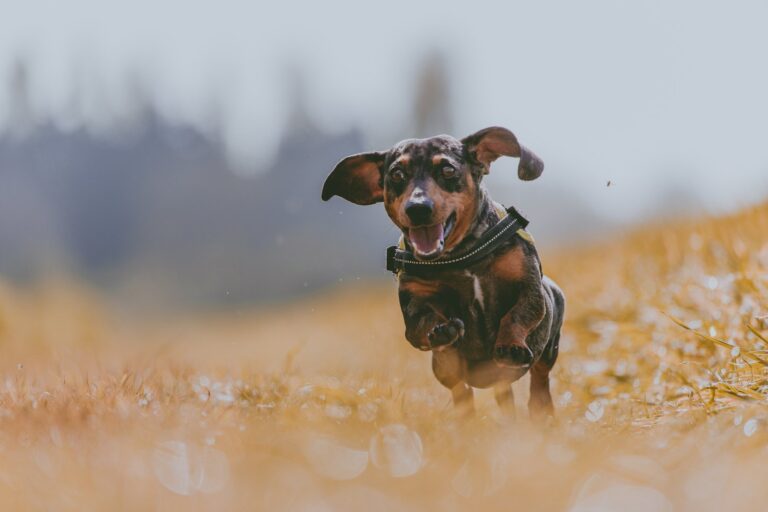Do Dachshunds Get Along With Other Pets?
One question that may be in mind if you are considering owning a dachshund is whether they will get along with other existing pets you may have, or the pets of family and friends. Dachshunds, like any other breed, can vary in their individual temperament, but many dachshunds are known for being sociable and adaptable, which can contribute to positive interactions with other pets.
Here are some general considerations on introducing your dachshund to other animals:
Socialisation
Early socialisation is crucial for dachshunds. If introduced to other pets, such as cats or other dogs, from a young age, they are more likely to get along well with them.
Socialising dachshunds is essential for fostering a well-rounded and confident temperament. Dachshunds are generally friendly but can be reserved or even slightly aloof if not exposed to various people, animals, and environments during the first few months. Early and positive socialisation experiences can help avoid any potential behavioural or aggression issues, ensuring that dachshunds grow up to be sociable, adaptable, and comfortable in a variety of situations, especially around other pets.
To socialise dachshunds effectively, it is crucial to expose them to diverse stimuli, such as different people, environments, sounds, and other animals, in a positive and controlled manner. This can include introducing them to other pets or meeting new friends, and exposing them to different sights and sounds. Engaging in obedience classes or group activities with other dogs can also contribute to their social development. Consistent positive interactions will not only help dachshunds become more sociable but will also strengthen the bond between them and their owners, fostering a happy and well-adjusted dog.
Dachshunds and Other Dogs
Dachshunds often get along with other dogs, especially if they are socialised early. However, some dachshunds may have a more dominant or territorial nature, so monitoring their interactions is important.
When dachshunds interact with other dogs their unique physique and spirited personality can create an interesting dynamic. Despite their small size, dachshunds often display a certain level of confidence and playfulness, while introducing them to a diverse range of dog breeds can be beneficial for fostering positive social behaviours. Supervised playdates or attending dog-friendly events provide valuable opportunities for dachshunds to learn appropriate social cues and engage in harmonious interactions with other dogs. Carefully integrating dachshunds into mixed-dog environments contributes not only to their social development but also enriches the broader community of furry friends.
There may also be a need for your dachshund to be regularly in the company of other dogs, especially if you use a service like a dog boarder or doggy day care. Personally we have found this has really helped our dachshund to become more confident and happy being around other dogs, where he was previously quite nervous. By introducing dachshunds in a controlled and supervised setting, this can help minimise anxiety and build a well-rounded dog.
Dachshunds and Cats
With proper introduction and socialisation, dachshunds can coexist peacefully with cats. Slow, controlled introductions and positive reinforcement can help foster a positive relationship.
Dachshunds, known for their hunting instincts and playful nature, may initially display curiosity or excitement when encountering a cat. To ease the introduction, it is advisable to allow the pets to familiarise themselves with each other’s scent before any direct interaction. Placing items like blankets or toys that carry the scent of the cat in the dachshund’s living space and vice versa can help both animals become accustomed to each other’s presence.
When the initial scent exchange has taken place, controlled and supervised face-to-face meetings are essential. These interactions should be brief, positive, and in a neutral space to prevent territorial conflicts. Reward-based reinforcement for calm behaviour from both the dachshund and the cat can create positive associations. Over time, as they become more accustomed to each other, gradual increases in supervised interaction can occur, allowing the dachshund and the cat to build trust and potentially form a peaceful coexistence.
Dachshunds and Small Pets
Introducing dachshunds to other small pets requires a cautious and gradual approach, given the breed’s hunting background and lively disposition. Small animals like rabbits, guinea pigs, or hamsters can be perceived as prey by dachshunds, triggering their natural instincts. Initial introductions should occur in a controlled environment, allowing the pets to observe each other without direct physical contact. Placing the smaller animals in secure cages or enclosures provides a safe way for the Dachshund to become acquainted with their scent and presence.
Supervised interactions should be short and positive, rewarding calm behaviour from the dachshund. It’s important to closely monitor the initial reactions and intervene if any signs of stress or aggression emerge. Gradually increasing the exposure and interaction time while maintaining a watchful eye helps in building trust between the dachshund and the smaller pets. Consistency in positive reinforcement, alongside careful management, can lead to a peaceful coexistence, fostering a relationship where the dachshund recognises the smaller pets as members of the household rather than as potential prey.
Training Your Dachshund
Obedience training is beneficial for dachshunds to understand commands and boundaries. Positive reinforcement can be particularly effective in reinforcing good behaviour around other pets.
Training a dachshund requires a blend of patience, consistency, and positive reinforcement, and they often respond well to reward-based training methods. Start with basic commands such as sit, stay, and come, offering treats and praise when the dachshund successfully follows instructions. Short, regular training sessions are more effective than prolonged ones, ensuring that the Dachshund remains engaged and focused.
Territorial Behaviour
Dachshunds, despite their small stature, can display a surprisingly strong territorial instinct, and this may be more noticeable in the presence of other animals. Providing each pet with their space and resources can help prevent conflicts.
Rooted in their history as hunting dogs, dachshunds might exhibit protective behaviour towards their living space or their owners. It’s essential to address territorial tendencies early on to prevent excessive barking, growling, or even aggression. One effective approach is gradual desensitisation, introducing the dachshund to various stimuli in a controlled manner. For instance, slowly exposing them to new people, pets, or environments and rewarding calm behaviour can help mitigate territorial reactions.
Creating a positive association with unfamiliar situations or individuals is crucial in managing territorial behaviour. Encouraging socialisation through controlled interactions and providing positive reinforcement for calm responses can help a dachshund become more accepting and less territorial. Establishing a consistent routine, setting clear boundaries, and offering ample mental and physical stimulation can also contribute to a balanced temperament, reducing the likelihood of territorial issues. Patience and positive reinforcement are key elements in addressing territorial behaviour, allowing your dachshund to feel secure and confident in various situations.
Individual Differences
Dachshunds are renowned for their distinctive and varied personalities, often influenced by factors such as genetics, upbringing, and individual temperament. The breed is known for its intelligence, curiosity, and a degree of stubbornness. Some dachshunds may exhibit a more independent nature, while others might be more affectionate and eager to please. This diversity in personalities can significantly impact how they interact with other pets. Dachshunds with a more assertive or dominant disposition may require careful introductions to other pets, as they might attempt to establish their role in the hierarchy. On the other hand, more easygoing and sociable dachshunds may readily accept the presence of other animals and even form strong bonds with them.
Understanding the individual personality and temperament of a dachshund is crucial when introducing them to other pets. Sensitivity to their unique traits allows pet owners to tailor their approach to socialisation and ensure a positive experience for both the dachshund and the other animals. For instance, a shy dachshund may benefit from gradual introductions and a calm environment, while a more outgoing one might thrive on interactive play sessions. By acknowledging and working with the individual personalities of dachshunds, owners can facilitate harmonious relationships between their pets
Supervision
Always supervise interactions between your Dachshund and other pets, especially in the initial stages of introduction. This helps prevent misunderstandings and ensures the safety of all animals involved.
It’s worth noting that early positive experiences with other pets can significantly contribute to a dachshund’s ability to get along with them. If you’re introducing a dachshund to a household with existing pets, take it slow, use positive reinforcement, and seek professional advice if needed.
Additionally, individual pets have their own unique personalities, so success in multi-pet households often depends on the specific animals involved. Regular monitoring and positive reinforcement for good behaviour can contribute to a harmonious relationship between dachshunds and other pets.








